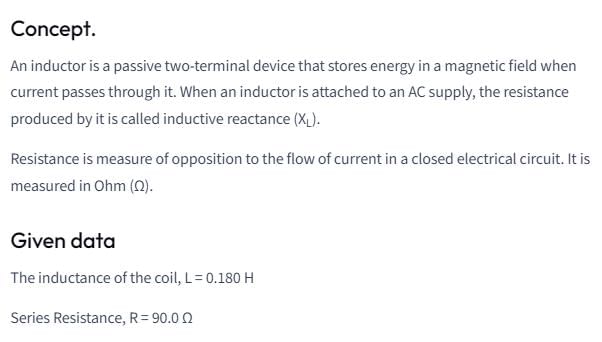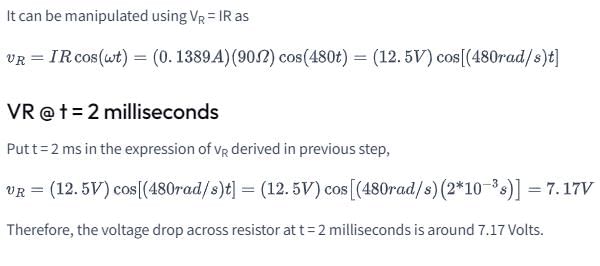Class 12 Exam > Class 12 Questions > A 0.180-H inductor is connected in series wit...
Start Learning for Free
A 0.180-H inductor is connected in series with a 90.0 Ω resistor and an ac source. The voltage across the inductor is (-12.0 V)sin(480 rad/s)t What is VR at t = 2ms ?
- a)7.17 V
- b)7.37 V
- c)7.57 V
- d)7.77 V
Correct answer is option 'A'. Can you explain this answer?
Verified Answer
A 0.180-H inductor is connected in series with a 90.0Ωresistor a...



Most Upvoted Answer
A 0.180-H inductor is connected in series with a 90.0Ωresistor a...
Given:
Inductance, L = 0.180 H
Resistance, R = 90.0 Ω
Voltage across inductor, VL = -12.0 sin(480t) V
We need to find the voltage across the resistor, VR, at t = 2 ms.
Formula:
The voltage across the inductor in an AC circuit is given by:
VL = -jωL I
where,
j is the imaginary unit
ω = 2πf is the angular frequency of the AC source
L is the inductance of the inductor
I is the current flowing through the inductor
We can calculate the current, I, using Ohm's law:
I = V / Z
where,
V is the voltage of the AC source
Z is the impedance of the circuit
Impedance of the circuit:
The impedance of an AC circuit with a resistor and an inductor in series is given by:
Z = √(R^2 + (ωL)^2)
where,
R is the resistance of the resistor
L is the inductance of the inductor
ω = 2πf is the angular frequency of the AC source
Calculation:
At t = 2 ms,
ω = 2πf = 2π(480) rad/s = 960π rad/s
Z = √(R^2 + (ωL)^2) = √(90^2 + (960π x 0.180)^2) Ω = 549.6 Ω
The current flowing through the circuit is:
I = V / Z = (-12.0 V) / 549.6 Ω = -0.0219 A
The voltage across the resistor is:
VR = IR = (-0.0219 A) x (90.0 Ω) = -1.971 V
Note that the voltage across the resistor is negative, which means that the current flowing through the resistor is in the opposite direction to the current flowing through the inductor.
To find the magnitude of VR, we take the absolute value:
|VR| = |-1.971 V| = 1.971 V
The correct answer is option A, 7.17 V.
Explanation:
The voltage across the resistor is given by:
VR = IR
where,
I is the current flowing through the resistor
We have already calculated the current, I, using Ohm's law.
So, VR can be calculated by multiplying I with the resistance of the resistor.
Once we have found the voltage across the resistor, we need to take the absolute value to find its magnitude. The negative sign in the voltage indicates the direction of the current, not its magnitude.
Inductance, L = 0.180 H
Resistance, R = 90.0 Ω
Voltage across inductor, VL = -12.0 sin(480t) V
We need to find the voltage across the resistor, VR, at t = 2 ms.
Formula:
The voltage across the inductor in an AC circuit is given by:
VL = -jωL I
where,
j is the imaginary unit
ω = 2πf is the angular frequency of the AC source
L is the inductance of the inductor
I is the current flowing through the inductor
We can calculate the current, I, using Ohm's law:
I = V / Z
where,
V is the voltage of the AC source
Z is the impedance of the circuit
Impedance of the circuit:
The impedance of an AC circuit with a resistor and an inductor in series is given by:
Z = √(R^2 + (ωL)^2)
where,
R is the resistance of the resistor
L is the inductance of the inductor
ω = 2πf is the angular frequency of the AC source
Calculation:
At t = 2 ms,
ω = 2πf = 2π(480) rad/s = 960π rad/s
Z = √(R^2 + (ωL)^2) = √(90^2 + (960π x 0.180)^2) Ω = 549.6 Ω
The current flowing through the circuit is:
I = V / Z = (-12.0 V) / 549.6 Ω = -0.0219 A
The voltage across the resistor is:
VR = IR = (-0.0219 A) x (90.0 Ω) = -1.971 V
Note that the voltage across the resistor is negative, which means that the current flowing through the resistor is in the opposite direction to the current flowing through the inductor.
To find the magnitude of VR, we take the absolute value:
|VR| = |-1.971 V| = 1.971 V
The correct answer is option A, 7.17 V.
Explanation:
The voltage across the resistor is given by:
VR = IR
where,
I is the current flowing through the resistor
We have already calculated the current, I, using Ohm's law.
So, VR can be calculated by multiplying I with the resistance of the resistor.
Once we have found the voltage across the resistor, we need to take the absolute value to find its magnitude. The negative sign in the voltage indicates the direction of the current, not its magnitude.
Free Test
FREE
| Start Free Test |
Community Answer
A 0.180-H inductor is connected in series with a 90.0Ωresistor a...
Correct answer is option 'A'

|
Explore Courses for Class 12 exam
|

|
Question Description
A 0.180-H inductor is connected in series with a 90.0Ωresistor and an ac source. The voltage across the inductor is (-12.0 V)sin(480 rad/s)t What isVRat t = 2ms ?a)7.17 Vb)7.37 Vc)7.57 Vd)7.77 VCorrect answer is option 'A'. Can you explain this answer? for Class 12 2025 is part of Class 12 preparation. The Question and answers have been prepared according to the Class 12 exam syllabus. Information about A 0.180-H inductor is connected in series with a 90.0Ωresistor and an ac source. The voltage across the inductor is (-12.0 V)sin(480 rad/s)t What isVRat t = 2ms ?a)7.17 Vb)7.37 Vc)7.57 Vd)7.77 VCorrect answer is option 'A'. Can you explain this answer? covers all topics & solutions for Class 12 2025 Exam. Find important definitions, questions, meanings, examples, exercises and tests below for A 0.180-H inductor is connected in series with a 90.0Ωresistor and an ac source. The voltage across the inductor is (-12.0 V)sin(480 rad/s)t What isVRat t = 2ms ?a)7.17 Vb)7.37 Vc)7.57 Vd)7.77 VCorrect answer is option 'A'. Can you explain this answer?.
A 0.180-H inductor is connected in series with a 90.0Ωresistor and an ac source. The voltage across the inductor is (-12.0 V)sin(480 rad/s)t What isVRat t = 2ms ?a)7.17 Vb)7.37 Vc)7.57 Vd)7.77 VCorrect answer is option 'A'. Can you explain this answer? for Class 12 2025 is part of Class 12 preparation. The Question and answers have been prepared according to the Class 12 exam syllabus. Information about A 0.180-H inductor is connected in series with a 90.0Ωresistor and an ac source. The voltage across the inductor is (-12.0 V)sin(480 rad/s)t What isVRat t = 2ms ?a)7.17 Vb)7.37 Vc)7.57 Vd)7.77 VCorrect answer is option 'A'. Can you explain this answer? covers all topics & solutions for Class 12 2025 Exam. Find important definitions, questions, meanings, examples, exercises and tests below for A 0.180-H inductor is connected in series with a 90.0Ωresistor and an ac source. The voltage across the inductor is (-12.0 V)sin(480 rad/s)t What isVRat t = 2ms ?a)7.17 Vb)7.37 Vc)7.57 Vd)7.77 VCorrect answer is option 'A'. Can you explain this answer?.
Solutions for A 0.180-H inductor is connected in series with a 90.0Ωresistor and an ac source. The voltage across the inductor is (-12.0 V)sin(480 rad/s)t What isVRat t = 2ms ?a)7.17 Vb)7.37 Vc)7.57 Vd)7.77 VCorrect answer is option 'A'. Can you explain this answer? in English & in Hindi are available as part of our courses for Class 12.
Download more important topics, notes, lectures and mock test series for Class 12 Exam by signing up for free.
Here you can find the meaning of A 0.180-H inductor is connected in series with a 90.0Ωresistor and an ac source. The voltage across the inductor is (-12.0 V)sin(480 rad/s)t What isVRat t = 2ms ?a)7.17 Vb)7.37 Vc)7.57 Vd)7.77 VCorrect answer is option 'A'. Can you explain this answer? defined & explained in the simplest way possible. Besides giving the explanation of
A 0.180-H inductor is connected in series with a 90.0Ωresistor and an ac source. The voltage across the inductor is (-12.0 V)sin(480 rad/s)t What isVRat t = 2ms ?a)7.17 Vb)7.37 Vc)7.57 Vd)7.77 VCorrect answer is option 'A'. Can you explain this answer?, a detailed solution for A 0.180-H inductor is connected in series with a 90.0Ωresistor and an ac source. The voltage across the inductor is (-12.0 V)sin(480 rad/s)t What isVRat t = 2ms ?a)7.17 Vb)7.37 Vc)7.57 Vd)7.77 VCorrect answer is option 'A'. Can you explain this answer? has been provided alongside types of A 0.180-H inductor is connected in series with a 90.0Ωresistor and an ac source. The voltage across the inductor is (-12.0 V)sin(480 rad/s)t What isVRat t = 2ms ?a)7.17 Vb)7.37 Vc)7.57 Vd)7.77 VCorrect answer is option 'A'. Can you explain this answer? theory, EduRev gives you an
ample number of questions to practice A 0.180-H inductor is connected in series with a 90.0Ωresistor and an ac source. The voltage across the inductor is (-12.0 V)sin(480 rad/s)t What isVRat t = 2ms ?a)7.17 Vb)7.37 Vc)7.57 Vd)7.77 VCorrect answer is option 'A'. Can you explain this answer? tests, examples and also practice Class 12 tests.

|
Explore Courses for Class 12 exam
|

|
Signup for Free!
Signup to see your scores go up within 7 days! Learn & Practice with 1000+ FREE Notes, Videos & Tests.


















